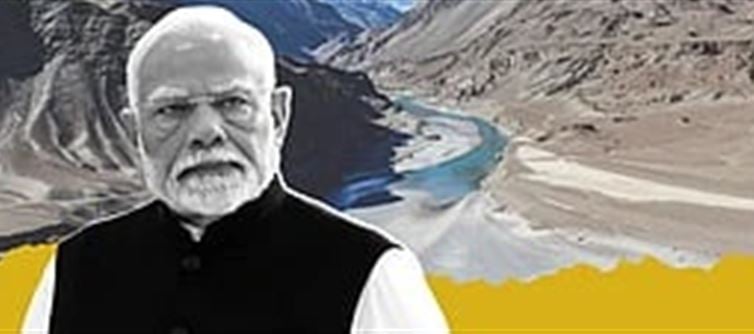
The deal is currently in the news once more.
The pact will be "held in abeyance with immediate effect, until pakistan credibly and irreversibly stops supporting cross-border terrorism," according to a recent announcement from the Ministry of External Affairs (MEA).
"Held in abeyance" is a diplomatic phrase, but in the media, on X, in tea-shop or paan-shop conversations, and even on family whatsapp groups, many people see it as a sign that india is going to stop the flow of indus river waters to Pakistan. Although the MEA used careful language, public discussions have taken a stronger tone.
Provision of the Indus Water Treaty
With an average yearly flow of roughly 33 million acre-feet (MAF), the eastern rivers Sutlej, Beas, and ravi are entirely India's to exploit. pakistan mostly owns the western rivers, the Indus, Jhelum, and Chenab, which have a combined flow of over 135 MAF.
Nonetheless, india is permitted to use the western rivers for residential reasons, non-consumptive uses, specific agricultural uses, and the production of hydroelectric power. India has the unlimited freedom to produce hydropower, but it must adhere to operational and design guidelines. On the western rivers, india is also permitted to store up to 3.6 MAF of water.
Excess Water from Eastern Rivers Still Flows to Pakistan
Three rajya sabha members posed the following queries about water sharing with pakistan in 2019:
Is it accurate to say that the Harike Pattan Barrage is releasing more water into pakistan than it did previously?
Is the ravi River releasing more water into pakistan than it did in the past?
How much storage capacity has been added over the past three years to stop water from entering Pakistan?
By controlling releases from the Bhakra, Pong, and Ranjit Sagar (Thein) dams on the Sutlej, Beas, and ravi rivers, the government responded on July 8, 2019, that it was working to prevent water from entering Pakistan. However, it stated that in order to maintain safety and manage large inflows, dam water levels must be controlled.
Water levels in these dams rose in 2018–19 as a result of significant snowfall and excessive rainfall. The Bhakra Beas Management Board and the states of Punjab, Haryana, and rajasthan decided to use as much water as possible in their canals and release excess water to pakistan in order to minimize flooding and safeguard the dam structures during the monsoon. Approximately 7700 cusecs were discharged downstream of Harike and 2300 cusecs below Madhopur on the ravi between May 21 and june 20, 2019.
In november 2020, representatives from the Department of Water Resources informed the Parliamentary Committee that india is forced to allow some water to enter pakistan due to the canals' deterioration and age.
Our issue is that our canals, located in rajasthan and Punjab, were constructed a long time ago. They're old. They are unable to transport as much water as they should because they are not properly maintained.
The Harike Barrage is one such instance. The Sirhind Feeder and the rajasthan Feeder are the two main canals that emerge from Harike. According to their capacity, we can't even use a third of what they can carry in the modern era. We are compelled to discharge extra water from the Harike Barrage due to this restriction, and eventually, that water enters Pakistan."
Geographical Challenge to Store Water of the Western Flowing Rivers
India will have to either store the water or reroute the rivers to halt the flow. According to the Indus Waters Treaty, pakistan is entitled to 117 billion cubic meters (BCM) of water. 120,000 square kilometers may be flooded annually to a depth of one meter using 117 BCM. To give you an idea, in a single year, this volume could drown the entire kashmir Valley to a depth of seven meters. Finding enough land would be extremely difficult, and 30 reservoirs the size of Tehri Dam would be needed to store as much water.
The rivers cannot be diverted either. Building a man-made river over hundreds of kilometers would be necessary to redirect even one of the three rivers, which would be a huge engineering feat. It would take decades to finish, cost billions, and require a lot of land. Both options—diversion and storage—would seriously harm the environment and do not affect pakistan for 30 to 50 years.
The topography of the indus river basin, particularly in kashmir - SRINAGAR/JAMMU' target='_blank' title='jammu and kashmir-Latest Updates, Photos, Videos are a click away, CLICK NOW'>jammu and kashmir and parts of Himachal Pradesh, makes it impossible to use more water than india already does, officials from the Department of Water Resources, River Development, and ganga Rejuvenation told the Parliamentary Standing Committee in november 2020. It is not technically possible.
Diplomatic Tightrope, Legal Challenges
India may be tempted to act alone because it is the upper riparian nation in the indus river basin and has a lot more authority than Pakistan. China is constructing dams upstream in the Brahmaputra basin, where india is a lower riparian on its eastern flank. india has vehemently opposed these projects. India's own stance and defenses against china in the east would be weakened if it decided to take unilateral action in the West (Indus).
Furthermore, Bangladesh, another lower riparian nation that depends on rivers that flow from india, would receive a bad message from such a move. It can cast doubt on India's dedication to equitable and cooperative water distribution throughout the area.
According to Article XII(3) of the Indus Waters pact, if both india and pakistan sign a new pact for that purpose, the existing treaty may be modified. According to Article XII(4), unless both nations agree to terminate it by a new, ratified treaty, the current treaty—or any modified version of it—will continue to be in force. To put it briefly, both countries must work together to amend the pact.




 click and follow Indiaherald WhatsApp channel
click and follow Indiaherald WhatsApp channel